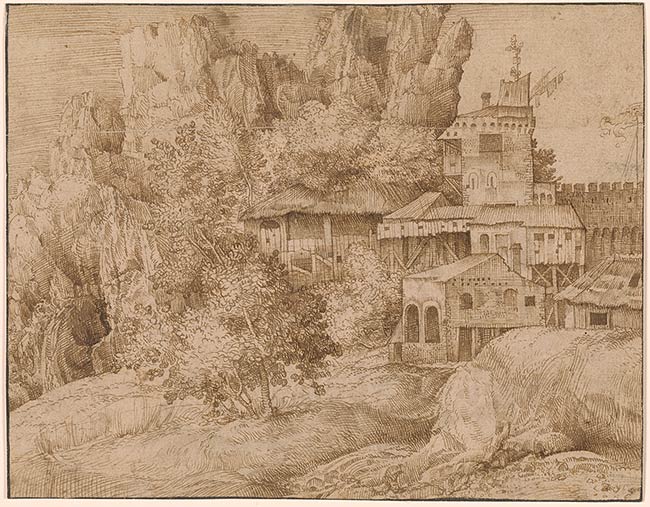

During the first decades of the sixteenth century, landscape became increasingly prominent in Venetian painting, first as the setting for religious or mythological scenes (see, for example, 2006.46) and eventually as a primary subject in its own right. Giorgione is rightly credited with a leading role in this evolution, but many other painters of the time, including Titian and Palma Vecchio, likewise began to devote increasing attention to the art of landscape. The developing contemporary interest in the graphic arts and the evolving notion of drawings as autonomous works led, moreover, to the rise of a related Venetian genre of highly detailed pen drawings of landscapes, including the present work. Titian would come to dominate this field, but the early practitioners also included the Paduan printmaker Giulio Campagnola as well as Giulio’s adopted son and artistic heir, Domenico Campagnola.
Buildings in a Rocky Landscape is one of a group of drawings whose attribution has oscillated between Giulio and Domenico. It was given to the former when first published by Fairfax Murray, but all subsequent scholars attributed it to Domenico until 1995, when Elisabetta Saccomani, citing the support of Alessandro Ballarin, returned it to Giulio.1 More recently, Tobias Nickel returned the sheet to Domenico and included it as an early work of about 1517 in his catalogue raisonné of Domenico Campagnola’s landscape drawings.2
In a discussion of similar drawings at the National Gallery of Art, Andrew Robison offers a useful series of stylistic benchmarks for the two artists based on the characteristics of their signed prints and drawings.3 He noted, for example, that Giulio’s buildings have “thatched roofs that lay out like skirts,” with more vertical supports, clapboard siding that shows overlapping layers of planks, and “more buildings apparently on poles or stilts.” Giulio’s trees tend to be relatively loosely drawn, with light dissolving the forms of the leaves, in contrast to Domenico’s deeper contrasts of light and shade in his buildings and landscape as well as the trees. Domenico also tended to introduce curved cross-hatching to his forms, and in particular used hatching to fill in the hillocks and contours of the landscape. When evaluated on these terms, the present drawing seems relatively clearly to be Domenico’s work. As Nickel has noted, however, the shallow, almost scenographic definition of space, the clustering of buildings against the rock outcropping, and the relatively small format of the drawing (even if trimmed at top and right) suggest that it must have been made early in Domenico’s career, when he was most under Giulio’s influence, Nickel even wonders whether it might have been based on a lost composition by Giulio. In time, following models developed by Titian and others, Domenico’s landscapes tended toward expansive panoramas, with deep recessions into space (as seen, for example, in IV, 64)
—JJM
Footnotes:
- See Washington 1995–96, 150. Saccomani had previously (Saccomani 1982, 85) considered the sheet as by Domenico.
- Nickel 2017, 103–5, no. 59.
- Venice 2014–15, 51–56.
Watermark: none.
Formerly attributed to Giulio Campagnolo, Padua ca. 1482-ca. 1515 Venice(?).
Inscribed on verso of lining, at lower center, in pen and brown ink, "S.W. 304"; at lower left, in graphite, "Campaniolo"; at lower right, in graphite, "20".
Campagnola, Giulio, 1482?-1515? Formerly attributed to.
Murray, Charles Fairfax, 1849-1919, former owner.
Morgan, J. Pierpont (John Pierpont), 1837-1913, former owner.
Morgan, J. P. (John Pierpont), 1867-1943, former owner.
Rhoda Eitel-Porter and and John Marciari, Italian Renaissance Drawings at the Morgan Library & Museum, New York, 2019, no. 58.
Selected references: Fairfax Murray 1905-12, 1:59; Walker 1941, 143; Tietze and Tietze-Conrat 1944, no. 506; New York 1953, 16, no. 9; Toronto 1960, no. 57; New York 1965-66, 54-55, no. 81; Poughkeepsie 1968, 5; Avery 1972, 195; Goldstein 1973, 193; Venice 1976a, 116, no. 60; Saccomani 1982, 85, 93n6, 96n37, and 96n41; Zdanski 1992, no. D19; Paris 1993, 513; Washington 1995-96, 150-52; Brouard 2005, 105-6; Diefenthaler 2006, 27; Scrase 2011, 162; Nickel 2017, no. 59.
Collection J. Pierpont Morgan : Drawings by the Old Masters Formed by C. Fairfax Murray. London : Privately printed, 1905-1912, I, 59, repr.
Stampfle, Felice, and Jacob Bean. Drawings from New York collections. I: The Italian Renaissance. New York : Metropolitan Museum of Art : Pierpont Morgan Library, 1965, p. 54-55, no. 81, repr.
Scholz Venice 1976, p. 116, no. 60, repr.
